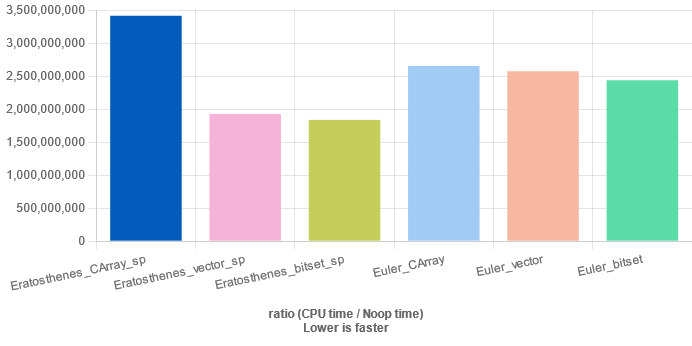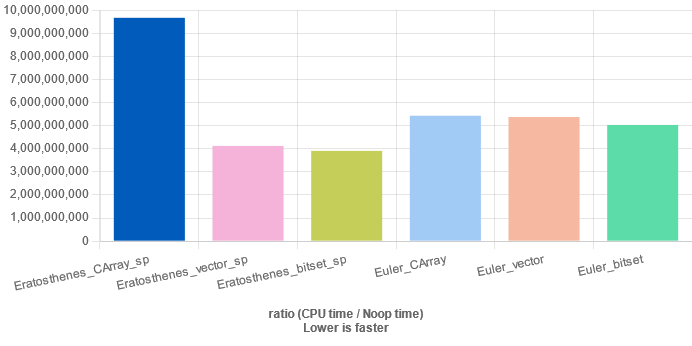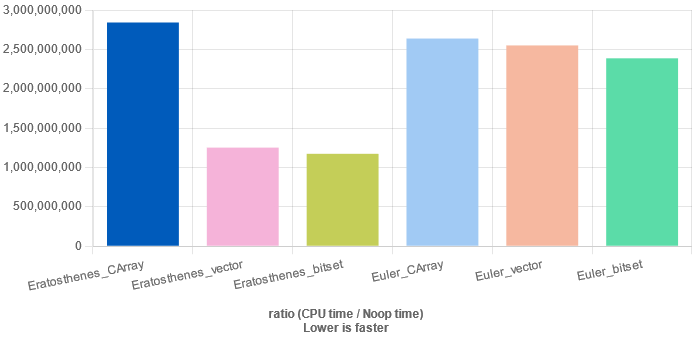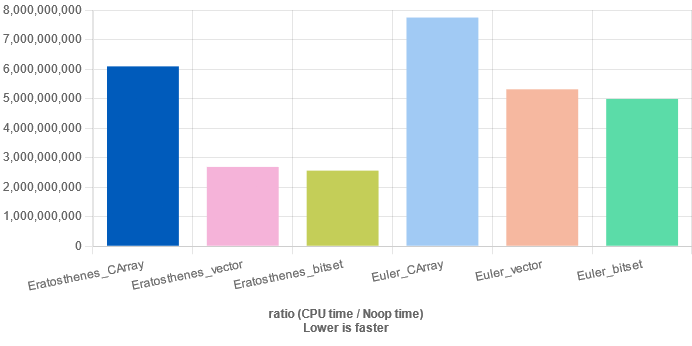bitset 介绍 std::bitset 是标准库中的一个存储 0/1 的大小不可变容器。严格来讲,它并不属于 STL。
bitset 与 STL The C++ standard library provides some special container classes, the so-called container adapters (stack, queue, priority queue). In addition, a few classes provide a container-like interface (for example, strings, bitsets, and valarrays). All these classes are covered separately.1 Container adapters and bitsets are covered in Chapter 12.
The C++ standard library provides not only the containers for the STL framework but also some containers that fit some special needs and provide simple, almost self-explanatory, interfaces. You can group these containers into either the so-called container adapters, which adapt standard STL containers to fit special needs, or a bitset, which is a containers for bits or Boolean values. There are three standard container adapters: stacks, queues, and priority queues. In priority queues, the elements are sorted automatically according to a sorting criterion. Thus, the "next" element of a priority queue is the element with the "highest" value. A bitset is a bitfield with an arbitrary but fixed number of bits. Note that the C++ standard library also provides a special container with a variable size for Boolean values: vector.
——摘自《The C++ Standard Library 2nd Edition》
由此看来,bitset 并不属于 STL,而是一种标准库中的 "Special Container"。事实上,它作为一种容器,也并不满足 STL 容器的要求。说它是适配器,它也并不依赖于其它 STL 容器作为底层实现。
由于内存地址是按字节即 byte 寻址,而非比特 bit,一个 bool 类型的变量,虽然只能表示 0/1, 但是也占了 1 byte 的内存。
bitset 就是通过固定的优化,使得一个字节的八个比特能分别储存 8 位的 0/1。
对于一个 4 字节的 int 变量,在只存 0/1 的意义下,bitset 占用空间只是其
在某些情况下通过 bitset 可以优化程序的运行效率。至于其优化的是复杂度还是常数,要看计算复杂度的角度。一般 bitset 的复杂度有以下几种记法:(设原复杂度为
bitset 完全没有优化复杂度。bitset 能将所需时间优化至 另外,vector 的一个特化 vector<bool> 的储存方式同 bitset 一样,区别在于其支持动态开空间,bitset 则和我们一般的静态数组一样,是在编译时就开好了的。然而,bitset 有一些好用的库函数,不仅方便,而且有时可以实现 SIMD 进而减小常数。另外,vector<bool> 的部分表现和 vector 不一致(如对 std::vector<bool> vec 来说,&vec[0] + i 不等于 &vec[i])。因此,一般不使用 vector<bool>。
使用 参见 std::bitset - cppreference.com 。
头文件
指定大小
std :: bitset < 1000 > bs ; // a bitset with 1000 bits
构造函数 bitset(): 每一位都是 false。bitset(unsigned long val): 设为 val 的二进制形式。bitset(const string& str): 设为 str。运算符 operator []: 访问其特定的一位。
operator ==/operator !=: 比较两个 bitset 内容是否完全一样。
operator &/operator &=/operator |/operator |=/operator ^/operator ^=/operator ~: 进行按位与/或/异或/取反操作。
注意:bitset 只能与 bitset 进行位运算bitset。
operator <</operator >>/operator <<=/operator >>=: 进行二进制左移/右移。
此外,bitset 还提供了 C++ 流式 IO 的支持,这意味着你可以通过 cin/cout 进行输入输出。
成员函数 count(): 返回 true 的数量。size(): 返回 bitset 的大小。test(pos): 它和 vector 中的 at() 的作用是一样的,和 [] 运算符的区别就是越界检查。any(): 若存在某一位是 true 则返回 true,否则返回 false。none(): 若所有位都是 false 则返回 true,否则返回 false。all(): 若所有位都是 true 则返回 true,否则返回 false。set(): 将整个 bitset 设置成 true。set(pos, val = true): 将某一位设置成 true/false。reset(): 将整个 bitset 设置成 false。reset(pos): 将某一位设置成 false。相当于 set(pos, false)。flip(): 翻转每一位。(bitset)flip(pos): 翻转某一位。to_string(): 返回转换成的字符串表达。to_ulong(): 返回转换成的 unsigned long 表达(long 在 NT 及 32 位 POSIX 系统下与 int 一样,在 64 位 POSIX 下与 long long 一样)。to_ullong():(C++11 起)返回转换成的 unsigned long long 表达。另外,libstdc++ 中有一些较为实用的内部成员函数
_Find_first(): 返回 bitset 第一个 true 的下标,若没有 true 则返回 bitset 的大小。_Find_next(pos): 返回 pos 后面(下标严格大于 pos 的位置)第一个 true 的下标,若 pos 后面没有 true 则返回 bitset 的大小。应用 这题可以用 dp 做,转移方程很简单:
但如果直接做的话是
发现可以用 bitset 优化,左移再或起来就好了:
提交记录:std::bitset 1
2
3
4
5
6
7
8
9
10
11
12
13
14
15
16
17
18
19
20
21
22
23
24
25
26
27
28
29
30 #include <bitset>
#include <cstdio>
#include <iostream>
using namespace std ;
constexpr int N = 101 ;
int n , a [ N ], b [ N ];
bitset < N * N * N > f [ N ];
int main () {
int i , j ;
cin >> n ;
for ( i = 1 ; i <= n ; ++ i ) cin >> a [ i ] >> b [ i ];
f [ 0 ][ 0 ] = 1 ;
for ( i = 1 ; i <= n ; ++ i ) {
for ( j = a [ i ]; j <= b [ i ]; ++ j ) {
f [ i ] |= ( f [ i - 1 ] << ( j * j ));
}
}
cout << f [ n ]. count ();
return 0 ;
}
由于 libstdc++ 的实现为压 __CHAR_BIT__ * sizeof(unsigned long) 位的bitset(只需要支持左移后或起来这一种操作)压 __CHAR_BIT__ * sizeof(unsigned long long))来进一步优化:
提交记录:手写 bitset 1
2
3
4
5
6
7
8
9
10
11
12
13
14
15
16
17
18
19
20
21
22
23
24
25
26
27
28
29
30
31
32
33
34
35
36
37
38
39
40
41
42
43
44
45
46
47
48
49 #include <cstdio>
#include <iostream>
using namespace std ;
constexpr int N = 101 ;
constexpr int W = 64 ;
struct Bitset {
unsigned long long a [ N * N * N >> 6 ];
void shiftor ( const Bitset & y , int p , int l , int r ) {
int t = p - p / W * W ;
int tt = ( t == 0 ? 0 : W - t );
int to = ( r + p ) / W ;
int qaq = ( p + W - 1 ) / W ;
for ( int i = ( l + p ) / W ; i <= to ; ++ i ) {
if ( i - qaq >= 0 ) a [ i ] |= y . a [ i - qaq ] >> tt ;
a [ i ] |= (( y . a [ i - qaq + 1 ] & (( 1ull << tt ) - 1 )) << t );
}
}
} f [ N ];
int main () {
int n , a , b , l = 0 , r = 0 , ans = 0 ;
scanf ( "%d" , & n );
f [ 0 ]. a [ 0 ] = 1 ;
for ( int i = 1 ; i <= n ; ++ i ) {
scanf ( "%d%d" , & a , & b );
for ( int j = a ; j <= b ; ++ j ) f [ i ]. shiftor ( f [ i - 1 ], j * j , l , r );
l += a * a ;
r += b * b ;
}
for ( int i = l / W ; i <= r / W ; ++ i )
ans += __builtin_popcount ( f [ n ]. a [ i ] & 0xffffffffu ) +
__builtin_popcount ( f [ n ]. a [ i ] >> 32 );
printf ( "%d" , ans );
return 0 ;
}
另外,加了几个剪枝的暴力也能过:
提交记录:加了几个剪枝的暴力 1
2
3
4
5
6
7
8
9
10
11
12
13
14
15
16
17
18
19
20
21
22
23
24
25
26
27
28
29
30
31
32
33
34
35
36
37
38
39
40
41
42 #include <cstdio>
#include <iostream>
using namespace std ;
constexpr int N = 101 ;
constexpr int W = 64 ;
bool f [ N * N * N ];
int main () {
int n , i , j , k , a , b , l = 0 , r = 0 , ans = 0 ;
scanf ( "%d" , & n );
f [ 0 ] = true ;
for ( i = 1 ; i <= n ; ++ i ) {
scanf ( "%d%d" , & a , & b );
l += a * a ;
r += b * b ;
for ( j = r ; j >= l ; -- j ) {
f [ j ] = false ;
for ( k = a ; k <= b ; ++ k ) {
if ( j - k * k < l - a * a ) break ;
if ( f [ j - k * k ]) {
f [ j ] = true ;
break ;
}
}
}
}
for ( i = l ; i <= r ; ++ i ) ans += f [ i ];
printf ( "%d" , ans );
return 0 ;
}
题意 给你
把某个可重集设为一个数。 把某个可重集设为另外两个可重集加起来。 把某个可重集设为从另外两个可重集中各选一个数的 询问某个可重集中某个数的个数,在模 2 意义下 。 可重集个数
做法 看到「在模 bitset 维护每个可重集。
这样的话,操作
我们可以尝试维护每个可重集的所有约数构成的可重集,这样的话,操作
我们可以把值域内每个数的约数构成的 bitset 预处理出来,这样操作
现在的问题是,如何通过一个可重集的约数构成的可重集得到该可重集中某个数的个数。
令原可重集为 莫比乌斯反演 推一推:
由于是模 bitset,求答案的时候先按位与再 count() 就好了。
这样的话,单次询问复杂度就是
至于预处理的部分,
参考代码 1
2
3
4
5
6
7
8
9
10
11
12
13
14
15
16
17
18
19
20
21
22
23
24
25
26
27
28
29
30
31
32
33
34
35
36
37
38
39
40
41
42
43
44
45
46
47
48
49
50
51
52
53
54
55
56
57
58
59
60
61
62
63
64
65
66
67
68
69
70
71
72
73
74 #include <bitset>
#include <cctype>
#include <cmath>
#include <cstdio>
#include <iostream>
using namespace std ;
int read () {
int out = 0 ;
char c ;
while ( ! isdigit ( c = getchar ()));
for (; isdigit ( c ); c = getchar ()) out = out * 10 + c - '0' ;
return out ;
}
constexpr int N = 100005 ;
constexpr int M = 1000005 ;
constexpr int V = 7005 ;
bitset < V > pre [ V ], pre2 [ V ], a [ N ], mu ;
int n , m , tot ;
char ans [ M ];
int main () {
int i , j , x , y , z ;
n = read ();
m = read ();
mu . set ();
for ( i = 2 ; i * i < V ; ++ i ) {
for ( j = 1 ; i * i * j < V ; ++ j ) {
mu [ i * i * j ] = 0 ;
}
}
for ( i = 1 ; i < V ; ++ i ) {
for ( j = 1 ; i * j < V ; ++ j ) {
pre [ i * j ][ i ] = 1 ;
pre2 [ i ][ i * j ] = mu [ j ];
}
}
while ( m -- ) {
switch ( read ()) {
case 1 :
x = read ();
y = read ();
a [ x ] = pre [ y ];
break ;
case 2 :
x = read ();
y = read ();
z = read ();
a [ x ] = a [ y ] ^ a [ z ];
break ;
case 3 :
x = read ();
y = read ();
z = read ();
a [ x ] = a [ y ] & a [ z ];
break ;
case 4 :
x = read ();
y = read ();
ans [ tot ++ ] = (( a [ x ] & pre2 [ y ]). count () & 1 ) + '0' ;
break ;
}
}
printf ( "%s" , ans );
return 0 ;
}
与埃氏筛结合 由于 bitset 快速的连续读写效率,使得它非常适合用于与 埃氏筛 结合打质数表。
使用的方式也很简单,只需要将埃氏筛中的布尔数组替换成 bitset 即可。
速度测试 使用 Quick C++ Benchmarks 进行测试,编译器采用 GCC 13.2,编译参数为 -std=c++20 -O2。
算法 函数名 埃氏筛 + C 风格布尔数组,不存储筛出来的素数 Eratosthenes_CArray埃氏筛 +vector<bool>,不存储筛出来的素数 Eratosthenes_vector埃氏筛 +bitset,不存储筛出来的素数 Eratosthenes_bitset埃氏筛 + C 风格布尔数组,存储筛出来的素数 Eratosthenes_CArray_sp埃氏筛 +vector<bool>,存储筛出来的素数 Eratosthenes_vector_sp埃氏筛 +bitset,存储筛出来的素数 Eratosthenes_bitset_sp欧拉筛 + C 风格布尔数组 Euler_CArray欧拉筛 +vector<bool> Euler_vector欧拉筛 +bitset Euler_bitset
当埃氏筛 存储 筛出来的素数时:
当埃氏筛 不存储 筛出来的素数时:
从测试结果中可知:
时间复杂度 bitset 或 vector<bool> 优化后,性能甚至超过时间复杂度 欧拉筛使用 bitset 或 vector<bool> 后的优化效果在大多数情况下均不明显; bitset 的优化效果略强于 vector<bool>。参考代码 需安装 google/benchmark 。
1
2
3
4
5
6
7
8
9
10
11
12
13
14
15
16
17
18
19
20
21
22
23
24
25
26
27
28
29
30
31
32
33
34
35
36
37
38
39
40
41
42
43
44
45
46
47
48
49
50
51
52
53
54
55
56
57
58
59
60
61
62
63
64
65
66
67
68
69
70
71
72
73
74
75
76
77
78
79
80
81
82
83
84
85
86
87
88
89
90
91
92
93
94
95
96
97
98
99
100
101
102
103
104
105
106
107
108
109
110
111
112
113
114
115
116
117
118
119
120
121
122
123
124
125
126
127
128
129
130
131
132
133
134
135
136
137
138
139
140
141
142
143
144
145
146
147
148
149
150
151
152
153
154
155
156
157
158
159
160
161
162
163
164
165
166
167
168
169
170
171
172
173
174
175
176
177
178
179
180
181
182 #include <benchmark/benchmark.h>
#include <bits/stdc++.h>
using namespace std ;
using u32 = uint32_t ;
using u64 = uint64_t ;
#define ERATOSTHENES_STORAGE_PRIME
#define ENABLE_EULER
constexpr u32 N = 5e7 + 1 ;
#ifndef ERATOSTHENES_STORAGE_PRIME
void Eratosthenes_CArray ( benchmark :: State & state ) {
static bool is_prime [ N ];
for ( auto _ : state ) {
fill ( is_prime , is_prime + N , true );
is_prime [ 0 ] = is_prime [ 1 ] = false ;
for ( u32 i = 2 ; ( u64 ) i * i < N ; ++ i )
if ( is_prime [ i ])
for ( u32 j = i * i ; j < N ; j += i ) is_prime [ j ] = false ;
benchmark :: DoNotOptimize ( 0 );
}
}
BENCHMARK ( Eratosthenes_CArray );
void Eratosthenes_vector ( benchmark :: State & state ) {
static vector < bool > is_prime ( N );
for ( auto _ : state ) {
fill ( is_prime . begin (), is_prime . end (), true );
is_prime [ 0 ] = is_prime [ 1 ] = false ;
for ( u32 i = 2 ; ( u64 ) i * i < N ; ++ i )
if ( is_prime [ i ])
for ( u32 j = i * i ; j < N ; j += i ) is_prime [ j ] = false ;
benchmark :: DoNotOptimize ( 0 );
}
}
BENCHMARK ( Eratosthenes_vector );
void Eratosthenes_bitset ( benchmark :: State & state ) {
static bitset < N > is_prime ;
for ( auto _ : state ) {
is_prime . set ();
is_prime . reset ( 0 );
is_prime . reset ( 1 );
for ( u32 i = 2 ; ( u64 ) i * i < N ; ++ i )
if ( is_prime [ i ])
for ( u32 j = i * i ; j < N ; j += i ) is_prime . reset ( j );
benchmark :: DoNotOptimize ( 0 );
}
}
BENCHMARK ( Eratosthenes_bitset );
#else
void Eratosthenes_CArray_sp ( benchmark :: State & state ) {
static bool is_prime [ N ];
for ( auto _ : state ) {
vector < u32 > prime ;
fill ( is_prime , is_prime + N , true );
is_prime [ 0 ] = is_prime [ 1 ] = false ;
for ( u32 i = 2 ; ( u64 ) i * i < N ; ++ i )
if ( is_prime [ i ])
for ( u32 j = i * i ; j < N ; j += i ) is_prime [ j ] = false ;
for ( u32 i = 2 ; i < N ; ++ i )
if ( is_prime [ i ]) prime . push_back ( i );
benchmark :: DoNotOptimize ( prime );
}
}
BENCHMARK ( Eratosthenes_CArray_sp );
void Eratosthenes_vector_sp ( benchmark :: State & state ) {
static vector < bool > is_prime ( N );
for ( auto _ : state ) {
vector < u32 > prime ;
fill ( is_prime . begin (), is_prime . end (), true );
is_prime [ 0 ] = is_prime [ 1 ] = false ;
for ( u32 i = 2 ; ( u64 ) i * i < N ; ++ i )
if ( is_prime [ i ])
for ( u32 j = i * i ; j < N ; j += i ) is_prime [ j ] = false ;
for ( u32 i = 2 ; i < N ; ++ i )
if ( is_prime [ i ]) prime . push_back ( i );
benchmark :: DoNotOptimize ( prime );
}
}
BENCHMARK ( Eratosthenes_vector_sp );
void Eratosthenes_bitset_sp ( benchmark :: State & state ) {
static bitset < N > is_prime ;
for ( auto _ : state ) {
vector < u32 > prime ;
is_prime . set ();
is_prime . reset ( 0 );
is_prime . reset ( 1 );
for ( u32 i = 2 ; ( u64 ) i * i < N ; ++ i )
if ( is_prime [ i ])
for ( u32 j = i * i ; j < N ; j += i ) is_prime . reset ( j );
for ( u32 i = 2 ; i < N ; ++ i )
if ( is_prime [ i ]) prime . push_back ( i );
benchmark :: DoNotOptimize ( prime );
}
}
BENCHMARK ( Eratosthenes_bitset_sp );
#endif
#ifdef ENABLE_EULER
void Euler_CArray ( benchmark :: State & state ) {
static bool not_prime [ N ];
for ( auto _ : state ) {
vector < u32 > prime ;
fill ( not_prime , not_prime + N , false );
not_prime [ 0 ] = not_prime [ 1 ] = true ;
for ( u32 i = 2 ; i < N ; ++ i ) {
if ( ! not_prime [ i ]) prime . push_back ( i );
for ( u32 pri_j : prime ) {
if ( i * pri_j >= N ) break ;
not_prime [ i * pri_j ] = true ;
if ( i % pri_j == 0 ) break ;
}
}
benchmark :: DoNotOptimize ( prime );
}
}
BENCHMARK ( Euler_CArray );
void Euler_vector ( benchmark :: State & state ) {
static vector < bool > not_prime ( N );
for ( auto _ : state ) {
vector < u32 > prime ;
fill ( not_prime . begin (), not_prime . end (), false );
not_prime [ 0 ] = not_prime [ 1 ] = true ;
for ( u32 i = 2 ; i < N ; ++ i ) {
if ( ! not_prime [ i ]) prime . push_back ( i );
for ( u32 pri_j : prime ) {
if ( i * pri_j >= N ) break ;
not_prime [ i * pri_j ] = true ;
if ( i % pri_j == 0 ) break ;
}
}
benchmark :: DoNotOptimize ( prime );
}
}
BENCHMARK ( Euler_vector );
void Euler_bitset ( benchmark :: State & state ) {
static bitset < N > not_prime ;
for ( auto _ : state ) {
vector < u32 > prime ;
not_prime . reset ();
not_prime . set ( 0 );
not_prime . set ( 1 );
for ( u32 i = 2 ; i < N ; ++ i ) {
if ( ! not_prime [ i ]) prime . push_back ( i );
for ( u32 pri_j : prime ) {
if ( i * pri_j >= N ) break ;
not_prime . set ( i * pri_j );
if ( i % pri_j == 0 ) break ;
}
}
benchmark :: DoNotOptimize ( prime );
}
}
BENCHMARK ( Euler_bitset );
#endif
static void Noop ( benchmark :: State & state ) {
for ( auto _ : state ) benchmark :: DoNotOptimize ( 0 );
}
BENCHMARK ( Noop );
BENCHMARK_MAIN ();
与树分块结合 bitset 与树分块结合可以解决一类求树上多条路径信息并的问题,详见 数据结构/树分块 。
与莫队结合 详见 杂项/莫队配合 bitset 。
计算高维偏序 详见 FHR 课件 。
参考资料与注释 2024/10/9 22:38:42 ,更新历史 在 GitHub 上编辑此页! ouuan , Xeonacid , abc1763613206 , CCXXXI , Chrogeek , cmpute , countercurrent-time , Enter-tainer , Henry-ZHR , i-Yirannn , Ir1d , ksyx , NachtgeistW , sshwy , StudyingFather , Tiphereth-A , yzy-1 CC BY-SA 4.0 和 SATA 


